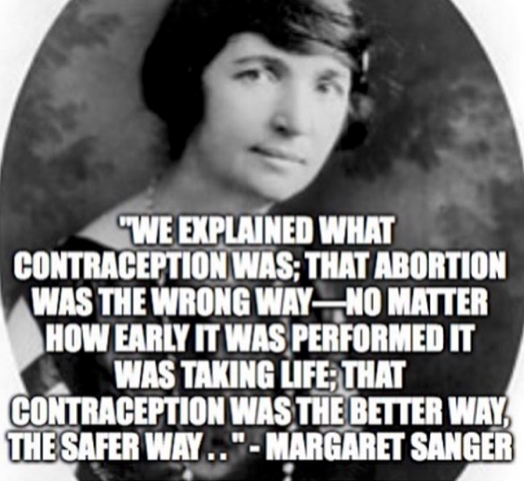Democrat Lack of Political Imagination
Margaret Sanger’s half century crusade for reproductive freedom spotlights 2020 Democrats lack of political imagination envisioning a post-Roe world where reproductive freedom is compatible with the criminalization of abortion. Sanger’s name has become synonymous with abortion on demand, a stereotype as surprising as it is historical revisionism. From 1916 until her death in 1966, Margaret Sanger was the world’s leading Right-to-Lifer founding the original anti-abortion movement.
Margaret Sanger
Sanger’s legacy has been much maligned as it has been fabricated. Smeared as a racist in present day by Alevda King and others, Sanger in fact transcended racial segregation by working with both the KKK Women’s Auxiliary and the National Council for Negro Women on family planning. Forgotten is Sanger opening a clinic in Harlem and later working with W.E.B. Dubois and Mary McLeod Bethune from the National Council of Negro Women to organize “the Negro Project” that ultimately floundered after others seized control from Sanger. Forgotten is during Hitler’s rise to power Sanger joined the American Council Against Nazi Propaganda and used her relationships in Europe to establish an un-official “refugee department” assisting multiple refugees in escaping Nazi Germany. Forgotten is Coretta Scott King accepting Planned Parenthood’s Margaret Sanger Award on behalf of Martin Luther King Jr. praising her and her work in 1966.
(https://www.nyu.edu/projects/sanger/articles/bc_or_race_control.php)
(https://www.nyu.edu/projects/sanger/articles/sanger-hitler_equation.php)
Also forgotten is Sanger’s role for several decades as a right-to-lifer and America’s leading abortion opponent.
Nearly a century before Mother Teresa pronounced abortion “is murder by the mother herself” Margaret Sanger was distributing family planning literature declaring;
“MOTHERS! / Can you afford to have a large family? / Do you want any more children? / If not, why do you have them? / DO NOT KILL, / DO NOT TAKE LIFE / BUT PREVENT”
In the 1870s, the women’s suffrage movement was strongly united against abortion in general. Victoria Woodhull, the first woman to run for President, Abigail Scott Duniway, Elizabeth Cady Stanton and members of the National Women’s Suffrage Association were firmly against abortion. Not until the start of the twentieth century did the women’s rights movement see a sharp schism over abortion with a new developing perspective of abortion as a woman’s legal right to self-ownership. Mother Earth journal reported;
“So strong this conviction has been that in the Woman’s Congress of 1905, as in practically all of their writings, these women claimed, the right of abortion and advocated the abolition of all punishment for abortion except when performed against the will of the pregnant woman herself. Such activity was of importance and value because it tended to emphasize the fact that the true enemies of woman are not men individually, but the corrupt and enslaving forces of the State — representing the industrial masters, the Church, Morality, Custom.”
In the Suffragette Movement, Alice Paul adamantly shutdown support for abortion refusing to allow the National Woman’s Party become a platform for abortion rights. Rebecca Reyher recalled to The Suffragist Oral History Project during the 1970s;
“I would never have made a speech in which I talked about birth control, or the right of women to have abortions, I knew that was obviously something that she had said we should not do.”
On the other hand Jeannette Rankin, the first woman elected to Congress and instrumental in passing the 19th Amendment, informed the Oral History Project, she and others were prepared to support legalized abortion but the timing hadn’t been right. In Europe the Soviet Union legalized abortion in 1920 under the supervision of the Women’s Bureau headed by Alexandra Kollontai and the debate raged in the Weimer Republic during the twenties and thirties.
(http://bancroft.berkeley.edu/ROHO/projects/suffragist/)
In her 1931 Autobiography Living My Life, New York City Mother Earth Anarchist Editor and Midwife Emma Goldman made it clear her 1910’s campaigns for contraception had nothing to do with fetal life;
“I could, of course, induce an abortion. . . It was not any moral consideration for the sanctity of life; a life unwanted and forced into abject poverty did not seem sacred to me. But my interests embraced the entire social problem, not merely a single aspect of it, and I would not jeopardize my freedom for that one part of the human struggle. I refused to perform abortions and I knew no methods to prevent conception.”
Goldman’s radical movement included two medical professionals. Goldman’s lover abortionist Ben Reitman (who later performed a traumatic second trimester abortion on birth control journalist Dorothy Day) and Margaret Sanger, a nurse to the Lower East Side frequently called to tend maternity cases (and whose own mother had endured eighteen pregnancies).
On a daily basis Sanger witnessed the harsh realities of New York City’s maternity crisis. In her autobiography Sanger paints a picture that has been recycled over and over again by abortion rights activists as justification for legalized abortion;
“Pregnancy was a chronic condition among the women of this class. Suggestions as to what to do for a girl who was “in trouble” or a married woman who was “caught” passed from mouth to mouth — herb teas, turpentine, steaming, rolling downstairs, inserting slippery elm, knitting needles, shoe-hooks. When they had word of a new remedy they hurried to the drugstore, and if the clerk were inclined to be friendly he might say, “Oh, that won’t help you, but here’s something that may.” The younger druggists usually refused to give advice because, if it were to be known, they would come under the law; midwives were even more fearful. The doomed women implored me to reveal the “secret” rich people had, offering to pay me extra to tell them; many really believed I was holding back information for money,; They asked everybody and tried anything, but nothing did them any good.
On Saturday nights I have seen groups of from fifty to one hundred with their shawls over their heads waiting outside the office of a five-dollar abortionist.
Each time I returned to this district, which was becoming a re-current nightmare, I used to hear that Mrs. Cohen “had been carried to a hospital, but had never come back,’* or that Mrs. Kelly “had sent the children to a neighbor and had put her head into the gas oven.” Day after day such tales were poured into my ears — a baby born dead, great relief — the death of an older child, sorrow but again relief of a sort — the story told a thousand times of death from abortion and children going into institutions. I shuddered with horror as I listened to the details and studied the reasons back of them —destitution linked with excessive childbearing. The waste of life seemed utterly senseless. One by one worried, sad, pensive, and aging faces marshaled themselves before me in my dreams, sometimes appealingly, sometimes accusingly.”
For Sanger the situation came to a head when she was called to treat Sadie Sachs, a young mother who nearly died from a self-induced abortion and was refused birth control information by the doctor when asked how she could avoid pregnancy in the future. A few months later Sanger was sent for again arriving too late, Sachs had died from another self-induced abortion attempt.
Sanger however took a decidedly different view of the situation from Goldman and much of the movement regarding reproductive freedom. Unlike Goldman, Kollontai and even the 1905 Woman’s Congress, Sanger did not view abortion as simply a medical procedure giving women the right to their bodies and was appalled at the practice. In 1931 she summarized the situation she had seen:
“But during all the long years this matter has been discussed, advocated, refuted, the people themselves—poor people especially—were blindly, desperately practicing family limitation, just as they are practicing it today. To them birth control does not mean what it does to us. To them it has meant the most barbaric methods. It has meant the killing of babies—infanticide,—abortions,—in one crude way or another.”
And Sanger made it her life mission to disrupt that violent method of family limitation. Also forgotten is that before she was a birth control activist, family planning advocate, Sanger was first and foremost a nurse dedicated to relieving human suffering. And Sanger was not the first female medical professional in American history to focus on disrupting abortion. Elizabeth Blackwell, the first woman licensed to practice medicine recorded her outrage that notorious New York Abortionist Madame Restell was publicly described as a “female physician;”
The gross perversion and destruction of motherhood by the abortionist filled me with indignation, and awakened active antagonism. That the honorable term ‘female physician’ should be exclusively applied to those women who carried on this shocking trade seemed to me a horror. It was an utter degradation of what might and should become a noble position for women…. I finally determined to do what I could do ‘to redeem the hells,’ and especially the one form of hell thus forced upon my notice.
Dr. Charlotte Lozier refused to assist with abortions and had men trying to procure them for their lovers prosecuted. In 1914, Sanger would focus on her entire life mission towards legalizing contraception first publishing The Woman Rebel and a book Family Limitation in defiance of Federal Law banning sharing information about contraception. In 1916 Sanger opened the first family planning clinic in New York City urging mothers not to resort to abortion but to come to her for information on contraception. In her autobiography Sanger recalled;
“To each group we explained simply what contraception was, that abortion was the wrong way—no matter how early it was performed it was taking life, that contraception is the better, the safer way.”
After being arrested twice and a hunger strike, sensationalized in New York Press by Dorothy Day, Sanger appealed her convictions winning a ruling that medical doctors have the right to prescribe contraception to patients under their care. In her writings Sanger frequently wrote about abortion spending the remainder of her life dedicated to disrupting abortion and miscarriage by promoting birth control. Years before the National Right to Life Committee formed in 1967, Planned Parenthood of America circulated educational materials against abortion as murder:
[Is Abortion Birth Control?] Definitely not. An abortion requires an operation. It kills the life of a baby after it has begun. It is dangerous to your life and health. It may make you sterile, so when you want children you cannot have them. Birth control merely postpones the beginning of life; abortion kills life.
Planned Parenthood did not endorse abortion until after Margaret Sanger’s death in 1966. Abortionist Bernard Nathanson, co-founder with Larry Later and Betty Friedan of the National Association for the Repeal Abortion Laws (NARAL), later revealed in his memoir Aborting America (1979) that he and Larry Later had knowingly appropriated Margaret Sanger’s arguments for birth control to push abortion, knowing that Sanger was ALWAYS opposed to abortion and that what they were doing was going directly against her principles.
2020 Democrats
Sanger era of Family Planning not only disrupted the abortion practice it created a fertile political ground where Democrats both focused on identifying the social problems affecting women and developed the political imagination necessary to help real women and their families. In 1961, the Presidential Commission on the Status of Women was formed under the leadership of Eleanor Roosevelt. In 1963, Democrat activist and journalist Betty Friedan published The Feminine Mystique. Also in 1963, Congress passed the Federal Equal Pay Act. The following year included “sex” as a protected category in the Civil Rights Act. In 1965, the Supreme Court established it a right to privacy to obtain contraception for married couples. In 1966 the National Organization for Women was co-founded by twenty six women and Betty Friedan to lobby for enforcement of Civil Rights Legislation.
Not until the 1970s did Democrats start adopting abortion rights, returning to pre-Sanger poverty practices as social solution for socio-economic problems. Not until Democrats adopted abortion rights into their platform did they begin drawing fire from Democrat women recognizing the hypocrisy of campaigning for civil rights while dismantling right to life and the social democracy that supported it. Graciela Olivarez, co-founder of the National Organization for Women and Carter Administration Director of Community Services Administration, summarized the gaping lack of willingness to envision a better world for women in her “Separate Statement to the President’s Commission on Population and the American Future”
“I am not impressed or persuaded by those who express concern for the low-income woman who may find herself carrying an unplanned pregnancy and for the future of the unplanned child who may be deprived of the benefits of a full life as the result of the parents’ poverty, because the fact remains that in this affluent nation of ours, pregnant cattle and horses receive better health care then pregnant poor women.
The poor cry out for justice and we respond with legalized abortion.”
( http://consistent-life.org/blog/index.php/2016/09/27/poor-cry-for-justice/ )
2020 Democrat Presidential Candidates are doing no better. Twenty candidates have qualified for the first round of Democrat debates and their platforms for women have consisted of advocating an 18th century practice, termed barbaric in the 20th Century as a 21st Century platform. The same Democrat candidates that proudly declare they will create Universal Healthcare, Childcare and Basic Income, ideas that have never been proven or implemented have yet to unveil a program to re-create the economic security of the nuclear family with a single breadwinner working a forty hour work week (something that America has already achieved). In 2020, they are unable to conceive a post-Roe world where women live happy lives without regular access to abortion that Margaret Sanger articulated in 1916. In the process not only are they advocating murder as a solution to social problems they display a tunnel vision that makes it clear they really don’t care about real women or their families.












